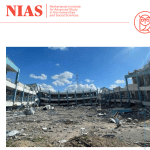Even while the U.S. economy is booming and creating jobs at a rapid pace, there are skill shortages in millions of jobs that remain unfilled. According to the most recent workforce data from the U.S. Chamber of Commerce, the country is experiencing a historic talent deficit, with the industries most affected being professional and business services, healthcare, education, and hospitality. And 2025 might be your lucky break if you’re a skilled worker hoping to get employment in the United States.
Whether you’re looking for a job abroad or are thinking about changing careers in the United States, let’s analyze the facts, analyze the industries experiencing a crisis, and find out what this enormous labor gap implies for you.
Read Also:
- UK Shawki Saad Fully Funded PhD Scholarship for Africans 2025 at the Imperial College London
- Call for Applications: University of Macerata (UniMC) Scholarships 2025 for International Students in Italy
- Study in the UK: University of York Fully Funded PhD Studentship in Music Cognition 2025 (Stipend of £20,780 with yearly increases)
- The United States Offers Foreign Talent STEM Work Visa Opportunities in 2025
Table of Contents
What’s Causing the Skill Shortage in the United States?
- A declining number of native workers and early retirements.
- Reductions in immigration both during and after the outbreak.
- Shortage of qualified personnel for new positions in biotechnology, sustainability, and artificial intelligence.
- A discrepancy between workers’ locations and employment locations, particularly in the transportation and construction industries.
The Most Critical Industries With Skill Deficits
The industries most in need of talent are revealed in the U.S. Chamber’s March 2025 report:
| Sector | Key Roles | Current Trends | Best For |
|---|---|---|---|
| 1. Professional & Business Services | Legal, financial, tech jobs, landscaping, cleaning, waste management | Over 1 million job openings as of Q1 2025 | International professionals with degrees or certifications in IT, business, or science |
| 2. Education & Health Services | Nurses, therapists, K–12 teachers, university professors | Hiring at an all-time high, especially in aging states or areas with post-pandemic learning gaps | Educators and healthcare professionals seeking stable, high-demand roles |
| 3. Leisure & Hospitality | In-person roles in restaurants, hotels, tourism | Hiring is at an all-time high, especially in aging states or areas with post-pandemic learning gaps | Job seekers wanting face-to-face work in dynamic, customer-facing environments |
| 4. Manufacturing | Skilled tradespeople, engineers, technicians | 622,000 unfilled roles; industry still rebounding from COVID-era job losses | Technical workers and tradespeople skilled in durable goods manufacturing |
| 5. Financial Activities & IT | Fintech, data science, cybersecurity | Low quit rates, high competition for top-tier talent | Remote/hybrid professionals in finance and IT fields |
Skilled Workers: Why the U.S. Needs You in 2025
The U.S. labor crisis is a visa-wrapped opportunity for qualified workers abroad. Hiring people from other countries is becoming essential for American businesses that are unable to locate local talent quickly enough.
2025 is the year to take the jump for the following reasons:
- More work visas, particularly H-1B, O-1, and TN (for qualified North Americans), are being sponsored by employers.
- Global talent is becoming more accessible through remote and hybrid choices in consulting, IT, and finance.
- Due to the Chamber’s recommendation that companies “expand hiring pools,” your international qualifications may finally open doors that were previously closed.
Which US regions will be most affected by the skill shortage in 2025?
There are currently fewer than 40 people available for every 100 positions in numerous states, according to the Chamber’s Worker Shortage Index. States such as
- Utah
- Texas
- Florida
- North Carolina
- Tennessee.
These states are popular destinations for skilled immigrants and foreign professionals due to their pro-business environments, advantageous tax laws, and lower cost of living.
Types of U.S. Work Visas You Can Apply For in 2026
| Category | Visa Type | Purpose / Eligible Roles |
|---|---|---|
| Tech, Business, Science, and Finance | H-1B | Specialty occupations for professionals with a bachelor’s degree or higher |
| O-1 | For individuals with extraordinary ability in sciences, education, or business | |
| TN | For eligible professionals from Canada or Mexico under USMCA/NAFTA | |
| Healthcare and Medical | H-1B (Cap-Exempt) | For healthcare roles at nonprofit or research institutions |
| J-1 | For medical residencies, fellowships, or internships | |
| EB-2 Green Card | For advanced degree holders or those with exceptional ability in shortage fields (e.g., healthcare) | |
| Manufacturing, Construction, Skilled Trades | H-2B | Temporary, non-agricultural skilled work (e.g., machine operators, welders) |
| EB-3 Green Card | For skilled workers with at least 2 years of experience or training | |
| Hospitality, Food Service, Seasonal Work | H-2B | Seasonal jobs in hospitality, housekeeping, and culinary positions |
| J-1 Intern/Trainee | For individuals under 38 with related education or experience | |
| Education and Academic Roles | J-1 | For visiting teachers, scholars, and professors |
| H-1B | Used by universities and K–12 schools for certified teaching professionals |
Ref:









